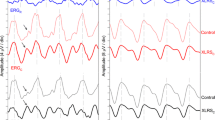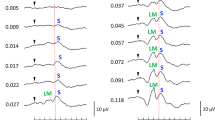Abstract
Purpose
To determine whether electroretinograms (ERGs) to heterochromatic stimulation can detect and quantify hereditary colour vision deficiency.
Methods
ERGs were measured to counterphase modulation of red and green stimuli. The total modulation depth of the red and green stimuli was constant. The ratio of red to green modulation was varied, and the responses were measured at two temporal frequencies: 12 and 36 Hz. Subjects were 13 protanopes, 19 protanomalous trichromats, 38 deuteranopes, 16 deuteranomalous trichromats and 22 normal trichromats.
Results
The responses are in agreement with previous findings: they were determined by a vector additive input of L- and M-cones (and thus is luminance sensitive) at 36 Hz. At 12 Hz, the responses can be modelled a vector addition of an L-/M-additive response (as determined by the 36 Hz ERGs) and an L-/M-opponent response. From the models, L-cone input fraction (36 Hz) and luminance input fraction (12 Hz) were estimated. The five groups showed different characteristics. However, the signal-to-noise ratio (SNR) at 12 Hz was not always satisfactory.
Conclusions
The ERGs to heterochromatic stimuli are potentially interesting for determining the presence and the type of colour vision deficiencies, provided some measures are taken to improve the 12 Hz SNRs.





Similar content being viewed by others
Notes
It has been argued that parvocellular cells could also be the physiological basis for luminance vision and thus has a “double-duty”. In our opinion, there are two arguments against this proposition: First, it has been found that the psychophysical sensitivities to isoluminant chromatic stimuli decrease for frequencies above about 4 Hz although the opponent cells respond well to these stimuli at much higher frequencies. It therefore has been suggested that there is a cortical filter in the opponent channel. It is difficult to imagine how such a filter would not involve luminance signals from opponent cells, particularly because these luminance signals manifest themselves at very high temporal frequencies (typically above about 40 Hz as it is caused by the small centre-surround latency difference in opponent cells). Second, The L/M ratio in the luminance channel is larger than one, can (dependent on subject, stimulus size, position, etc.) be as large 10:1 and is correlated with the ratio of L- to M-cone numbers. The L/M ratio in the chromatic channel is, however, about unity. It is difficult to conceive how different psychophysical L/M ratios can result from one underlying physiological mechanism.
References
Jacobs GH, Deegan Ii JF (1997) Spectral sensitivity of macaque monkeys measured with ERG flicker photometry. Vis Neurosci 14:921–928
Jacobs GH, Deegan IJS, Moran JL (1996) ERG measurements of the spectral sensitivity of common chimpanzee (Pan troglodytes). Vis Res 36:2587–2594
Jacobs GH, Neitz J (1993) Electrophysiological estimates of individual variation in the L/M cone ratio. In: Drum B (ed) Colour vision deficiencies XI. Kluwer Academic publishers, Dordrecht, pp 107–112
Jacobs GH, Neitz J, Krogh K (1996) Electroretinogram flicker photometry and its applications. J Opt Soc Am A: 13:641–648
Jacobs GH, Neitz J (1984) ERG Indices of color vision variations in monkeys. In: Verriest G (ed) Colour vision deficiencies VII. Dr. W Junk Publishers, The Hague, pp 49–54
Jacobs GH, Neitz J (1993) ERG flicker photometric evaluation of spectral sensitivity in protanopes and protanomalous trichromats. In: Drum B (ed) Colour vision deficiencies XI. Kluwer Academic Publishers, Dordrecht, pp 25–31
Jacobs GH, Neitz J (1991) Deuteranope spectral sensitivity measured with ERG flicker photometry. In: Drum B, Moreland JD, Serra A (eds) Colour vision deficiencies X. Kluwer Academic Publishers, Dordrecht, pp 405–411
Brainard DH, Roorda A, Yamauchi Y, Calderone JB, Metha AB, Neitz M, Neitz J, Williams DR, Jacobs GH (2000) Functional consequences of the relative numbers of L and M cones. J Opt Soc Am A: 17:607–614
Kremers J, Scholl HPN, Knau H, Berendschot TTJM, Usui T, Sharpe LT (2000) L/M cone ratios in human trichromats assesed by psychophysics, electroretinograpy, and retinal densitometry. J Opt Soc Am 17:517–526
Kremers J (2003) The assessment of L- and M-cone specific electroretinographical signals in the normal and abnormal retina. Prog Retinal Eye Res 22:579–605
Kremers J, Rodrigues AR, Silveira LCL, da Silva-Filho M (2010) Flicker ERGs representing chromaticity and luminance signals. Invest Ophthalmol Vis Sci 51:577–587
Parry NR, Murray IJ, Panorgias A, McKeefry DJ, Lee BB, Kremers J (2012) Simultaneous chromatic and luminance human electroretinogram responses. J Physiol 590:3141–3154
Jacob MM, Pangeni G, Gomes BD, Souza GS, Da Silva Filho M, Silveira LCL, Maguire J, Parry NRA, McKeefry D, Kremers J (2015) The spatial properties of L- and M-cone inputs to electroretinograms that reflect different types of post-receptoral processing. PLoS ONE 10:e0121218
Hunt DM, Jacobs GH, Bowmaker JK (2005) The genetics and evolution of primate visual pigments. In: Kremers J (ed) The primate visual system; a comparative approach. Wiley, Chichester, pp 73–98
Barboni MT, Pangeni G, Ventura DF, Horn F, Kremers J (2011) Heterochromatic flicker electroretinograms reflecting luminance and cone opponent activity in glaucoma patients. Invest Ophthalmol Vis Sci 52:6757–6765
Kremers J, Link B (2008) Electroretinographic responses that may reflect activity of parvo- and magnocellular post-receptoral visual pathways. J Vis 8:1–14
Crognale MA, Teller DY, Motulsky AG, Deeb SS (1998) Severity of color vision defects: electroretinographic (ERG), molecular and behavioral studies. Vis Res 38:3377–3385
Neitz J, Neitz M (1992) The molecular genetic basis of polymorphism in normal color vision. In: Advances in color vision technical digest, 1992 Optical Society of America, Washington, DC 4: 14–16
Neitz M, Neitz J, Grishok A (1995) Polymorphism in the number of genes encoding long-wavelength-sensitive cone pigments among males with normal color vision. Vis Res 35:2395–2407
Neitz M, Neitz J, Jacobs GH (1995) Genetic basis of photopigment variations in human dichromats. Vis Res 35:2095–2103
Huchzermeyer C, Schlomberg J, Welge-Lussen U, Berendschot TT, Pokorny J, Kremers J (2014) Macular pigment optical density measured by heterochromatic modulation photometry. PLoS ONE 9:e110521
Crognale MA, Teller DY, Yamaguchi T, Motulsky AG, Deeb SS (1999) Analysis of red/green color discrimination in subjects with a single X-linked photopigment gene. Vis Res 39:707–719
Barboni MT, Ventura DF, Kremers J (2010) Absence of ocular interaction in flicker ERG responses reflecting cone opponent and luminance signals. Doc Ophthalmol 121:69–75
Martins CM, Tsai T, Barboni MT, da Costa MF, Nagy B, Ventura DF, Kremers J (2016) The influence of stimulus size on heterochromatic modulation electroretinograms. J Vis 16:13
Tsai TI, Jacob MM, McKeefry D, Murray IJ, Parry NRA, Kremers J (2016) Spatial properties of L- and M-cone driven incremental (On-) and decremental (Off-) electroretinograms: evidence for the involvement of multiple post-receptoral mechanisms. J Opt Soc Am A: 33:A1–A11
Kremers J, Stepien MW, Scholl HPN, Saito CA (2003) Cone selective adaptation influences L- and M-cone driven signals in electroretinography and psychophysics. J Vis 3:146–160
Crognale MA, Switkes E, Rabin J, Schneck ME, Haegerstrom-Portnoy G, Adams AJ (1993) Application of the spatiochromatic visual evoked potential to detection of congenital and acquired color-vision deficiencies. J Opt Soc Am A Opt Image Sci Vis 10:1818–1825
Acknowledgments
DB wishes to thank Dr. Menuna Bahadur and Dr. Arundhati Malviya of the Department of Ophthalmology at the Dr. Babasaheb Ambedkar memorial railway hospital, Mumbai, for their continuous support.
Funding
The German Research Council (DFG) provided financial support in the form of Grant KR1317/13-1. The sponsor had no role in the design or conduct of this research.
Author information
Authors and Affiliations
Corresponding author
Ethics declarations
Conflict of Interest
All authors certify that they have no affiliations with or involvement in any organization or entity with any financial interest (such as honoraria; educational grants; participation in speakers’ bureaus; membership, employment, consultancies, stock ownership, or other equity interest; and expert testimony or patent-licensing arrangements), or non-financial interest (such as personal or professional relationships, affiliations, knowledge or beliefs) in the subject matter or materials discussed in this manuscript.
Statement of human rights
All procedures performed in studies involving human participants were in accordance with the ethical standards of the institutional and/or national research committee and with the 1964 Helsinki Declaration and its later amendments or comparable ethical standards.
Informed consent
Informed consent was obtained from all individual participants included in the study.
Statement on the welfare of animals
No animals were used in the present study.
Rights and permissions
About this article
Cite this article
Kremers, J., Bhatt, D. Towards an electroretinographic assay for studying colour vision in human observers. Doc Ophthalmol 133, 109–120 (2016). https://doi.org/10.1007/s10633-016-9561-y
Received:
Accepted:
Published:
Issue Date:
DOI: https://doi.org/10.1007/s10633-016-9561-y




